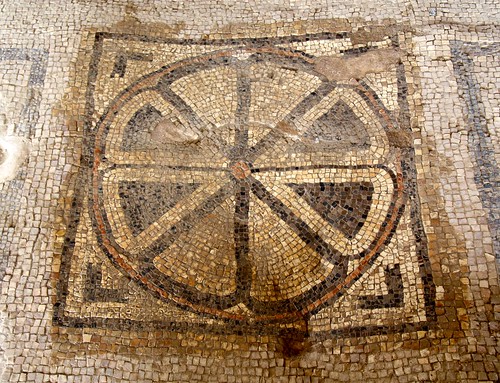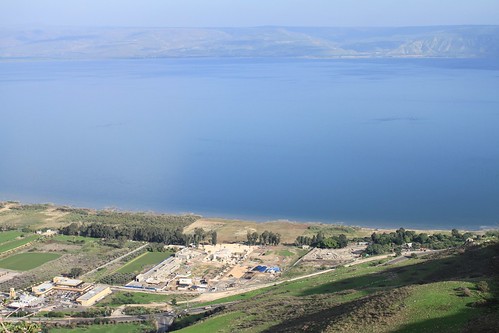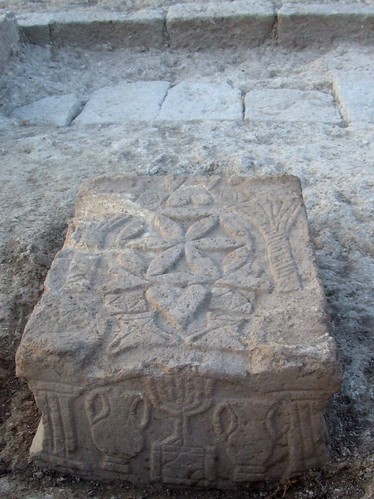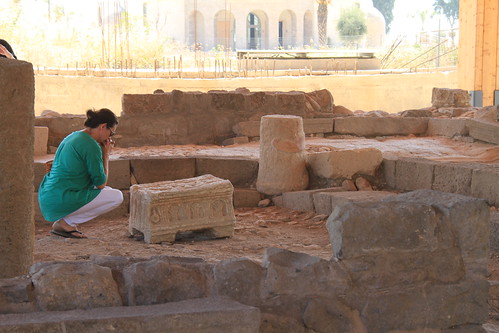For the first time, the original Magdala Stone will be exhibited at St. Peter’s Square and in the Great Synagogue of Rome.
Migdal, May 8th, 2017. The original Magdala Stone will be featured along with more than 100-menorah items, including paintings and documents in a simultaneous exhibition called “Menorah: Worship, History, Legend”. It will be held at Nel Braccio Di Carlo Magno next to St. Peter's Square and in the Great Synagogue of Rome, from May 15th until July 23rd. The Magdala Stone has the oldest carved menorah ever found and it is among the most important archaeological discoveries in Israel over the past 50 years.

Prof. Rina Talgam, Hebrew University of Jerusalem, who is currently studying the stone in cooperation with Chief Archaeologist Dina Gorni-Avshalom and Arfan Njjar from the Israel Antiquities Authority, describe it as a three-dimensional model of the most sacred parts of the First and Second Temple of Jerusalem and its various elements. Each of its faces, except for the bottom, is decorated with reliefs. One of those reliefs, is a seven-branched menorah, the first from this period found in the Galilee. It is the first time that a menorah appears on a Jewish religious structure as a Jewish symbol. Another characteristic is the top face, which consists of the golden showbread table and the veil, decorated with a large rosette, separating the Sanctuary from the Holy of Holies.
The Magdala Stone was found in the middle of a synagogue, which has been dated to the Second Temple Period and Jesus’s times. So far, it is the only well-decorated synagogue, with mosaics and frescoes, of the early first century found in Galilee. Additionally, Gorni and Njjar also found a market place and about forty fishing pools for the salted-fish industry during a 2009 surface test dig in Magdala. Currently, the archaeological team is looking forward to publishing a full report of their research about the Art of the Synagogue at the end of 2017.

“Magdala is looking forward to participating, with the presence of the Magdala Stone, at the Menorah exhibition next week. It is a great opportunity to bring Catholic and Jewish communities together in the Holy See for an encounter and dialogue about our common history and faith.”, said Fr. Juan Solana, LC, General Director of Magdala.
The Magdala Stone will be arriving in Rome in the following days and it will be set up for the opening in St. Peter’s square. The exhibition will be open to the public for three months and visitors will be able to have an encounter with it to promote dialogue about our common history and faith as Jews and Christians.

About the Magdala Stone
One of the most significant recent archaeological finds in the Holy Land, the Magdala Stone holds clues that will help scholars establish a more complete picture of first century Judaism. The Magdala Stone is likely the earliest known artistic depiction of the Second Temple. The front of the stone depicts the oldest carved image of the Second Temple’s seven-branched menorah ever found, and it is this discovery that has produced intense excitement among the archaeologists at Magdala.
The long side of the stone depicts the side of a building with pillared archways, with three-dimensional design to create the illusion of appearing inside the temple. The back of the stone depicts a pillared structure with two wheels above a geometric shape, illustrating fire. Presumably, the front and sides of the stone carvings represent the Second Temple in Jerusalem, and the back side depicting wheels and fire represents the Holy of Holies.
Also of great interest to scholars examining the stone is the large rosette on the top side of the stone, consisting of six petals surrounded by six identical petals. The symbolic meaning of this rosette has not yet been established, but the number twelve could relate to several biblical traditions and its prominence on the stone indicates it is certainly of great significance. The stone is covered in decorative symbols relating to the structure of the Temple and ceremonial Jewish objects that may unlock many unsolved mysteries which have long baffled archaeologists.

Photos: Magdala and the Israel Antiquities Authorities
